Disaster-Based Mobile Learning System Using Technology Acceptance Model †
Abstract
1. Introduction
2. Methodology
Software Development
3. Results and Discussions
3.1. Design and Features
3.2. Level of Technology Acceptance
4. Conclusions
Funding
Institutional Review Board Statement
Informed Consent Statement
Data Availability Statement
Conflicts of Interest
References
- Almaiah, M.A.; Alamri, M.M.; Al-Rahmi, W. Applying the UTAUT Model to Explain the Students’ Acceptance of Mobile Learning System in Higher Education. IEEE Access. 2019, 7, 174673–174686. [Google Scholar] [CrossRef]
- Zaidi, S.; Osmanaj, V.; Ali, O.; Zaidi, S. Adoption of mobile technology for mobile learning by university students during COVID-19. Int. J. Inf. Learn. Technol. 2021, 38, 329–343. [Google Scholar] [CrossRef]
- Venkatesh, V. Determinants of PEOU: Integrating control, intrinsic motivation, and emotion into the technology acceptance model. Inf. Syst. Res. 2000, 11, 342–365. [Google Scholar] [CrossRef]
- Alsharida, R.A.; Hammood, M.; Al-Emran, M. Mobile Learning Adoption: A Systematic Review of the Technology Acceptance Model from 2017 to 2020. Int. J. Emerg. Technol. Learn. 2021, 16, 147–162. [Google Scholar] [CrossRef]
- Nikou, S.; Economides, A. Mobile-based assessment: Integrating acceptance and motivational factors into a combined model of self-determination theory and technology acceptance. Comput. Hum. Behav. 2017, 68, 83–95. [Google Scholar] [CrossRef]
- Baghcheghi, N.; Karimy, H.R.; Alizadeh, S. Factors affecting mobile learning adoption in healthcare professional students based on technology acceptance model. Acta Fac. Medicae Naissensis. 2020, 37, 191–200. [Google Scholar] [CrossRef]
- Saroia, A.I.; Gao, S. Investigating university students’ intention to use mobile learning management systems in Sweden. Innov. Educ. Teach. Int. 2018, 56, 569–580. [Google Scholar] [CrossRef]
- Arain, A.; Hussain, Z.; Rizvi, W.H.; Vighio, M.S. Extending UTAUT2 toward acceptance of mobile learning in the context of higher education. Univers. Access Inf. Soc. 2019, 18, 659–673. [Google Scholar] [CrossRef]
- Almaiah, M.A.; Alismaiel, O. Examination of factors influencing the use of mobile learning system: An empirical study. Educ. Inf. Technol. 2018, 24, 885–909. [Google Scholar] [CrossRef]
- Almaiah, M.A.; Ayouni, S.; Hajjej, F.; Lutfi, A.; Almomani, O.; Awad, A.B. Smart Mobile Learning Success Model for Higher Educational Institutions in the Context of the COVID-19 Pandemic. Electronics. 2022, 11, 1278. [Google Scholar] [CrossRef]
- Wahyudi, J. The acceptance of a smartphone application for disaster: Technology acceptance model approach. IOP Conf. Ser. Earth Environ. Sci. 2023, 1180, 012002. [Google Scholar] [CrossRef]
- Brar, P.S.; Shah, B.; Singh, J.; Ali, F.; Kwak, D. Using Modified Technology Acceptance Model to Evaluate the Adoption of a Proposed IoT-Based Indoor Disaster Management Software Tool by Rescue Workers. Sensors. 2022, 22, 1866. [Google Scholar] [CrossRef] [PubMed]
- Prieto, J.C.S.; Olmos-Migueláñez, S.; García-Peñalvo, F. MLearning and pre-service teachers: An assessment of the BI using an expanded TAM model. Comput. Hum. Behav. 2017, 72, 644–654. [Google Scholar] [CrossRef]
- Machdar, N.M. The effect of information quality on PU and PEOU. Bus. Entrep. Rev. 2019, 15, 131–146. [Google Scholar] [CrossRef]
- Yalcin, M.E.; Kutlu, B. Examination of students’ acceptance of and intention to use learning management systems using extended TAM. Br. J. Educ. Technol. 2019, 50, 2414–2432. [Google Scholar] [CrossRef]
- Siagian, H.; Tarigan, Z.; Basana, S.R.; Basuki, R. The effect of perceived security, PEOU, and PU on consumer BIthrough trust in digital payment platform. Int. J. Data Netw. Sci. 2022, 6, 861–874. [Google Scholar] [CrossRef]
- Nielsen, J. Usability Engineering; Morgan Kaufmann: San Francisco, CA, USA, 1994. [Google Scholar]
- Tarhini, A.; Hone, K.; Liu, X.; Tarhini, T. Examining the moderating effect of individual-level cultural values on users’ acceptance of E-learning in developing countries: A structural equation modeling of an extended technology acceptance model. Interact. Learn. Environ. 2017, 25, 306–328. [Google Scholar] [CrossRef]
- Wu, M.-Y. Organizational Acceptance of Social Media Marketing: A Cross-Cultural Perspective. J. Intercult. Commun. Res. 2020, 49, 313–329. [Google Scholar] [CrossRef]
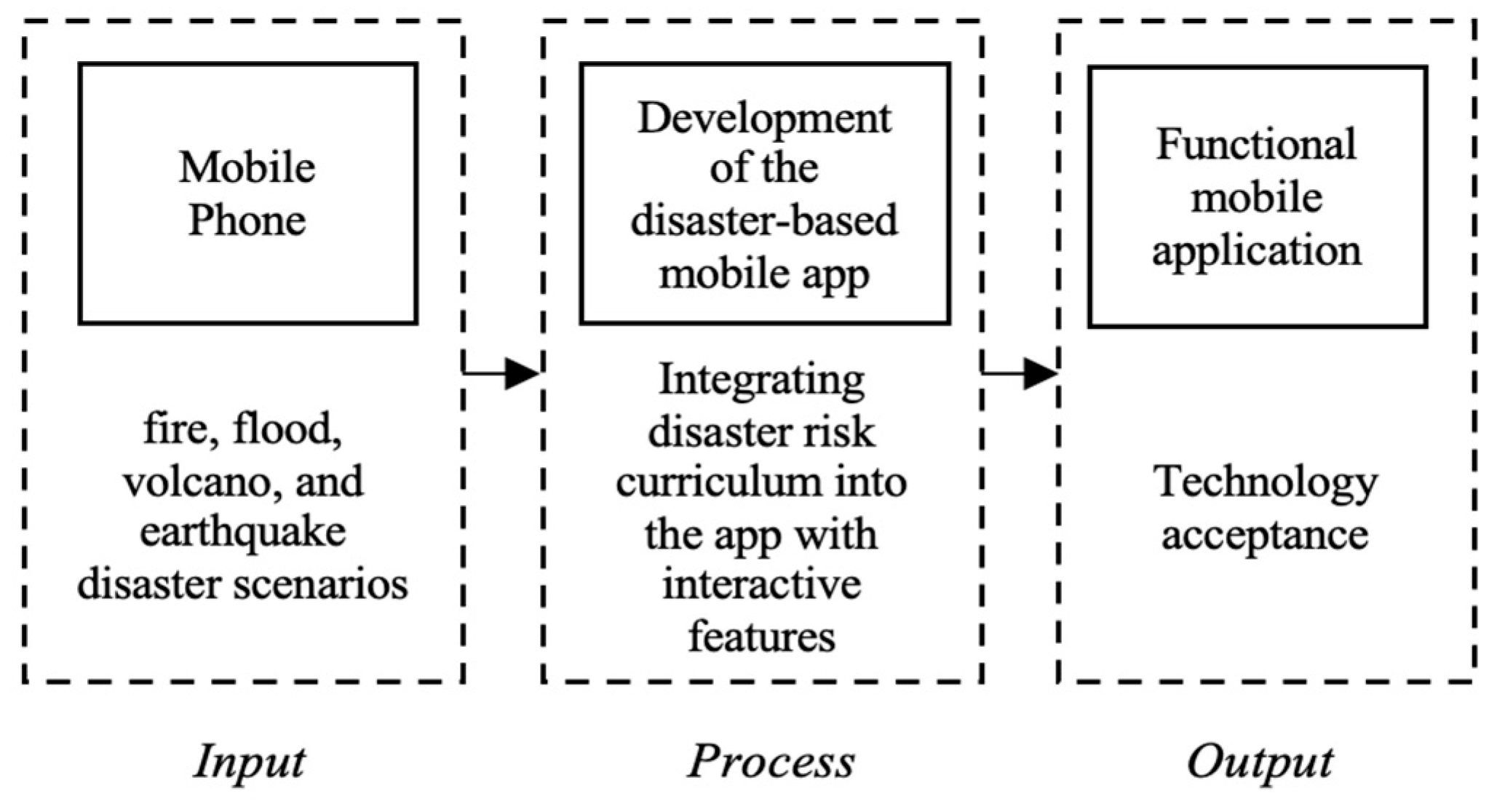

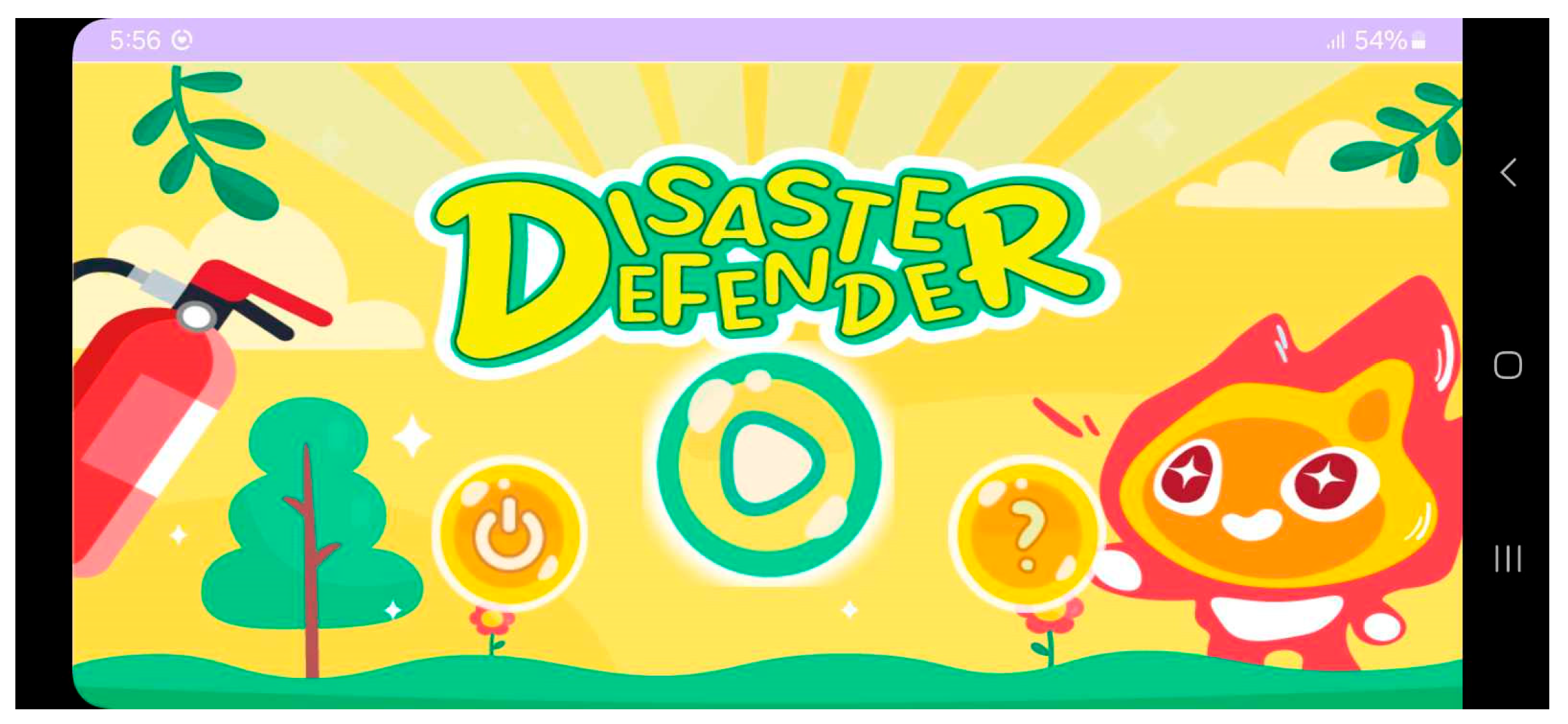

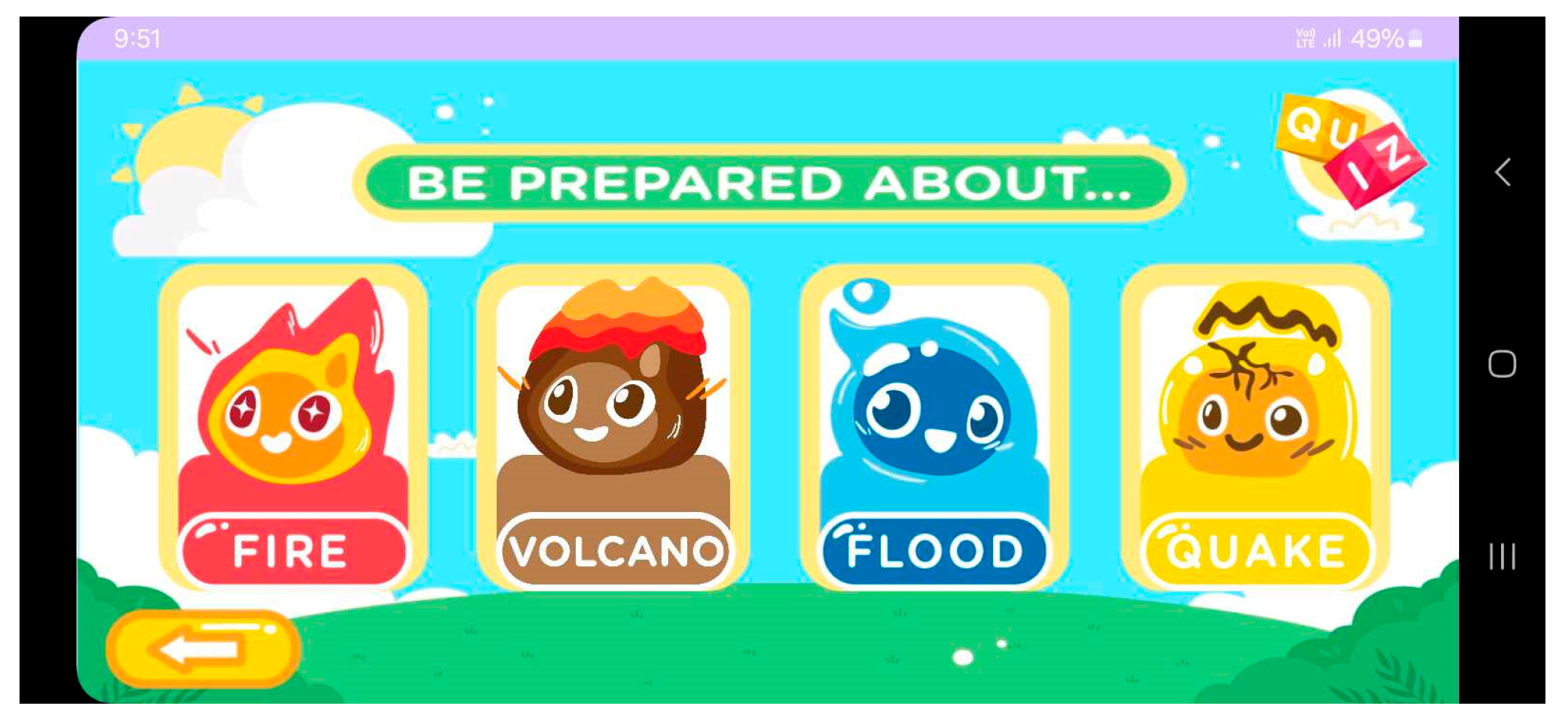
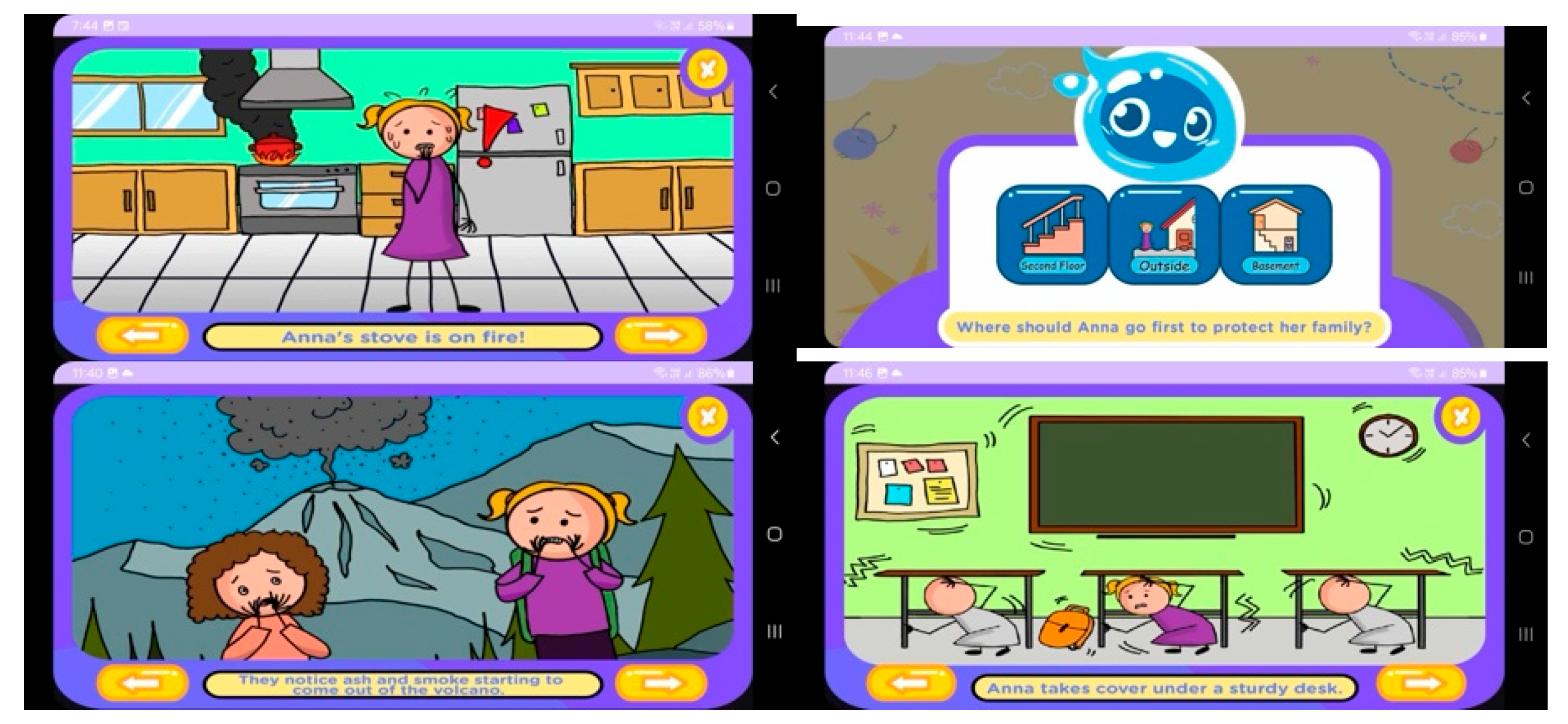
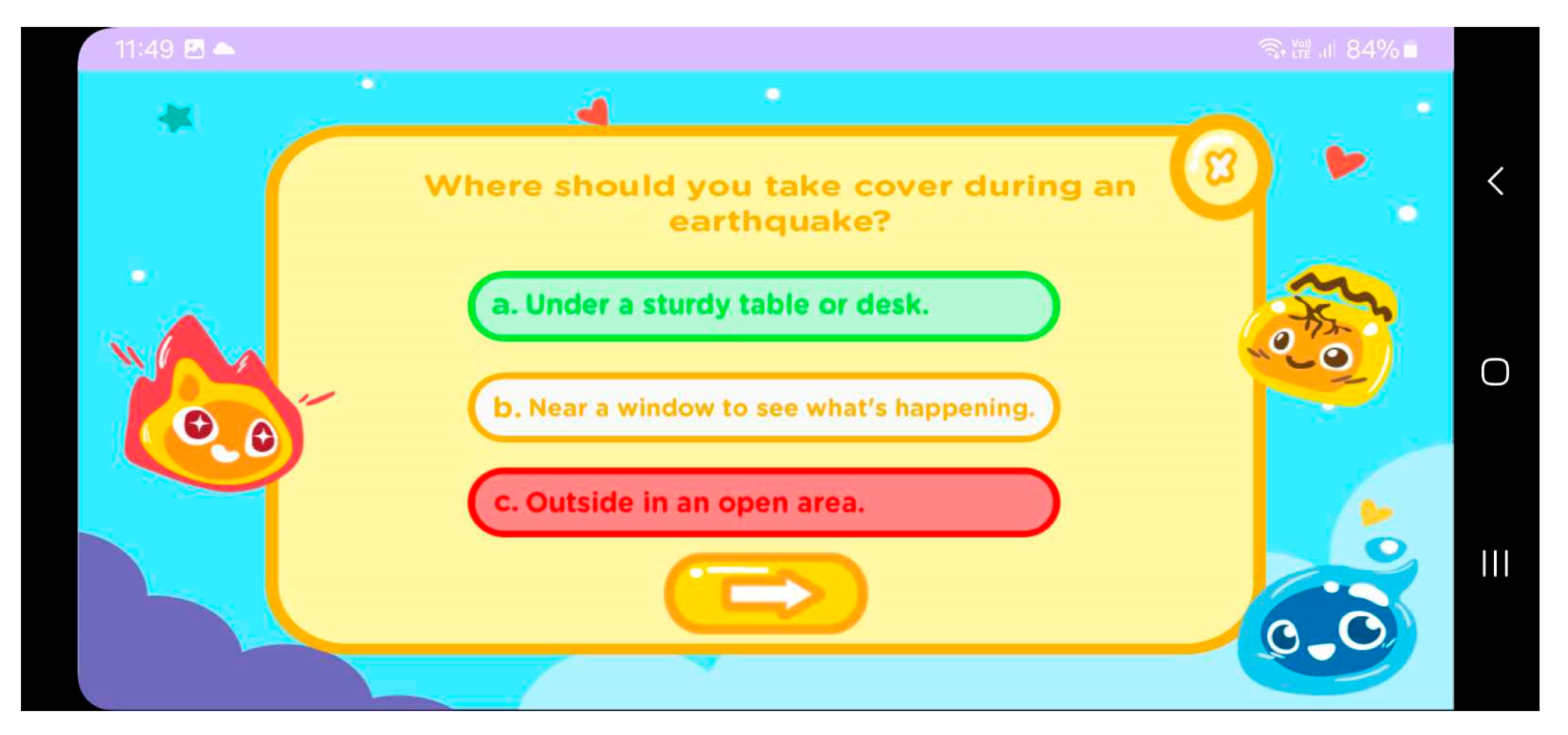
| PU |
|---|
| 1. The application helps me learn about what to do in emergencies. |
| 2. Using the application makes learning about safety fun. |
| 3. I can learn faster about disasters with the application. |
| 4. The application helps me remember what I learned about staying safe. |
| PEOU |
| 1. It is easy for me to use the application. |
| 2. I can easily find what I’m looking for in the application. |
| 3. I understand how to do things on the application. |
| 4. The pictures and words in the application are clear and easy for me to understand. |
| BI |
| 1. I would use the application every time we talk about safety at school. |
| 2. I would tell my friends to use the application too. |
| Weighted Mean | Descriptive Level | Interpretation |
|---|---|---|
| 4.20–5.00 | Very High | Users exhibit strong intentions to use the technology and perceive it as significantly enhancing their performance. |
| 3.40–4.19 | High | Users are inclined to use the technology and recognize its benefits, though minor reservations may exist. |
| 2.60–3.39 | Moderate | Users are undecided, seeing potential benefits but also facing uncertainties or usability concerns. |
| 1.80–2.59 | Low | Users show reluctance and minimal intention to use the technology, doubting its effectiveness or ease of use. |
| 1.00–1.79 | Very Low | Users exhibit strong resistance and little to no intention to use the technology, questioning its value altogether. |
| Mean | Standard Deviation | Interpretation | |
|---|---|---|---|
| PU | 4.52 | 0.55 | Very High |
| 1. The application helps me learn about what to do in emergencies. | 4.61 | 0.63 | |
| 2. Using the application makes learning about safety fun. | 4.49 | 0.69 | |
| 3. I can learn faster about disasters with the application. | 4.43 | 0.67 | |
| 4. The application helps me remember what I learned about staying safe. | 4.56 | 0.64 | |
| PEOU | 4.44 | 0.58 | Very High |
| 1. It is easy for me to use the application. | 4.46 | 0.71 | |
| 2. I can easily find what I’m looking for in the application. | 4.35 | 0.74 | |
| 3. I understand how to do things on the application. | 4.44 | 0.72 | |
| 4. The pictures and words in the application are clear and easy for me to understand. | 4.53 | 0.68 | |
| BI | 4.12 | 0.85 | High |
| 1. I would use the application every time we talk about safety at school. | 3.97 | 0.97 | |
| 2. I would tell my friends to use the application too. | 4.23 | 0.89 | |
| Overall TAM score | 4.36 | 0.67 |
Disclaimer/Publisher’s Note: The statements, opinions and data contained in all publications are solely those of the individual author(s) and contributor(s) and not of MDPI and/or the editor(s). MDPI and/or the editor(s) disclaim responsibility for any injury to people or property resulting from any ideas, methods, instructions or products referred to in the content. |
© 2025 by the author. Licensee MDPI, Basel, Switzerland. This article is an open access article distributed under the terms and conditions of the Creative Commons Attribution (CC BY) license (https://creativecommons.org/licenses/by/4.0/).
Share and Cite
Bacus, J.A. Disaster-Based Mobile Learning System Using Technology Acceptance Model. Eng. Proc. 2025, 103, 5. https://doi.org/10.3390/engproc2025103005
Bacus JA. Disaster-Based Mobile Learning System Using Technology Acceptance Model. Engineering Proceedings. 2025; 103(1):5. https://doi.org/10.3390/engproc2025103005
Chicago/Turabian StyleBacus, John A. 2025. "Disaster-Based Mobile Learning System Using Technology Acceptance Model" Engineering Proceedings 103, no. 1: 5. https://doi.org/10.3390/engproc2025103005
APA StyleBacus, J. A. (2025). Disaster-Based Mobile Learning System Using Technology Acceptance Model. Engineering Proceedings, 103(1), 5. https://doi.org/10.3390/engproc2025103005






